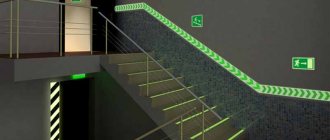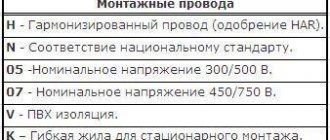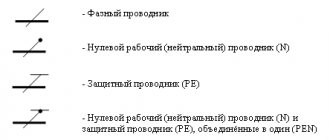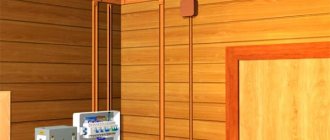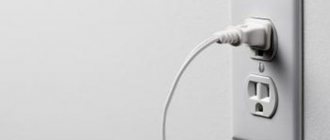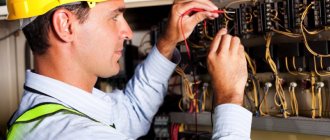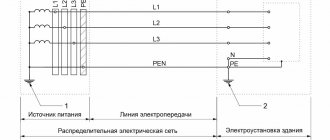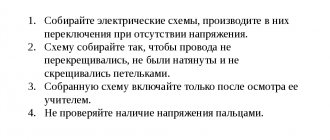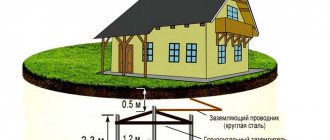One of the most common causes of fires is a short circuit in the electrical circuit. It can occur due to the fact that a faulty electrical appliance is connected to the network, or the insulation of the wire is broken, which leads to the connection of two conductors and a sharp increase in their temperature and subsequent fire. In addition, a short circuit often produces sparks that can ignite nearby flammable materials. This situation can be completely avoided by observing fire safety requirements for electrical installations.
Fire safety rules
Causes of fires in factories
Since fires often occur in enterprises, statistics on the causes of fires have long been compiled.
- 33% relates to violations related to the operation of technological equipment. For example, sparkling parts, poor insulation of electrical wiring, etc.
- 16% is untimely inspection and repair of electrical equipment.
- 13% - poor training of company employees in terms of fire safety at the enterprise, which also includes a poorly organized and equipped workplace.
- 10% - improper storage and use of flammable materials.
From practice we can conclude that not all employees treat their responsibilities as expected. This means that the management of the enterprise must strengthen control over everyone. And here well-developed fire safety rules at work will play an important role.
Personnel requirements
At energy facilities, as at any other important facility, there should be no unauthorized persons present. And all data about visits is recorded in the shift log
Additional fire safety requirements for electrical installations have been developed for personnel and employees.
Personnel and employees are not allowed to use damaged sockets and switches. All malfunctions must be reported to superiors in a timely manner, and problems must be corrected in a timely manner. All home-made devices, and especially devices with open heating elements, should never be used at work.
Factory-made devices can only be used in good condition and with good thermal insulation in the form of stands. Do not use the oven without thermoregulation.
Indoors and within a radius of 50 m outdoors, you must not use flammable materials or burn garbage and waste.
Legal regulation
The state pays considerable attention to fire safety issues during the operation of electrical installations. In order to prevent emergency situations, special technical regulations have been adopted, which set out a number of requirements for electrical devices and their operation in order to reduce the likelihood of fires:
- Electrical appliances located in premises must comply with the fire hazard class of such premises;
- If the building is constantly occupied by people, it must be equipped with an automatic fire extinguishing system with a backup power source, since the main electrical network may fail during a fire;
- Doors, elements of the fire extinguishing system, elevators, stairs and other objects through which people can evacuate must be in good working order and be able to function during a fire for a time that is sufficient to complete the evacuation process;
- Transformer cables and wires to provide a fire extinguishing system must be laid in fire-resistant channels and have insulation that is resistant to combustion and has a low level of smoke generation;
- The power supply system must be equipped with a special panel containing devices for its emergency shutdown in the event of a sharp increase in voltage, temperature, and so on. The shield itself must be fire-resistant and made of such material that in the event of a fire the flame cannot spread to nearby objects.
Technical regulations for fire safety
Fire safety requirements for electrical installations above 1000 V
Fire safety rules for operating electrical installations above 1000 volts are almost the same as in the previous section. But there are also distinctive features that mainly relate to protective equipment and devices. The latter must withstand increased voltage.
For example, insulating products are made from a polymer-rubber composite, which can withstand high voltage electrical current without much damage. Gloves, boots, bibs, mats, etc. are made from it.
The video shows how protective insulation products are tested:
The second group of products is respiratory protection. In fire safety of electrical installations, special attention is paid to such devices. These include gas masks, suits, shields and other devices that can not only protect against the effects of electricity, but also against high temperatures, toxic gases and other troubles associated with fire.
Absolutely forbidden
The following measures and actions, from a fire safety point of view, are unacceptable when operating electrical equipment in an enterprise, office or residential area:
- connect to the network electrical devices whose heating is higher than the ambient temperature by 40 degrees Celsius or more;
- use electrical equipment with damaged wire insulation and electric heating devices without fireproof stands;
- leaving electrical appliances on for a long time;
- connect homemade heating electrical appliances for heating;
- use wood for insulation;
- bringing explosive materials into the enterprise for employees;
- store flammable liquids near electrical devices and wiring.
Fire prevention
Fires at an enterprise can be prevented by observing fire safety measures when working with live equipment and performing preventive inspections of installations at least once a week:
- all personnel must be familiar with safety instructions when working with electrical equipment, and also know the procedure to follow in the event of a fire;
- The electrician should systematically carry out scheduled preventive inspections of live installations;
- wires and connections must be insulated, automatic regulators and fuses are installed throughout the building;
- store protective clothing and fire extinguishers in a separate room;
- at the end of the working day, on holidays and weekends, the entire electrical network in the institution must be turned off. The exception is automatic lighting.
Extinguishing electrical fires is a complex, painstaking job for the fire department. In order to avoid troubles with the Ministry of Emergency Situations, you need to carry out preventive measures in a timely manner and responsibly adhere to operating rules when working with electrical wiring and energized equipment.
Detailed information is visible in the video:
Fire safety measures when operating technological and household electrical appliances
Electricity and electrical appliances have become a part of modern life. Every day the range of electrical appliances, devices and machines, without which the life of a modern resident is already unthinkable, is increasing. These are electric irons, tiles, reflectors, fireplaces, radiators, floor polishers, washing machines, refrigerators, electric drills and other electrical appliances. True, people often neglect the rules for using these products of civilization.
With the onset of winter, when the air temperature begins to drop sharply, especially at night. According to statistics, during this period the risk of man-made fires, which often occur due to human fault, increases. Improper operation of electric heating devices, short circuits, heating of contact connections, load on electrical networks and the use of home-made heaters often become causes of fires, both in residential buildings and at industrial facilities.
To prevent this from happening, it is necessary to comply with safety requirements when working with electrical appliances. In my report, I will name the causes of fires and electric shocks, and also tell you how to prevent phenomena dangerous to human health and property and what should be done if a person is electrocuted.
Fire statistics
Every year, on average, about 150 thousand fires occur in Russia, during which about 10 thousand people die and the same number receive injuries and burns. Over the past 10 years, the number of tragedies has been increasing. 80% of all fires and 90% of fatalities occur in housing. And the number of fires in housing is steadily increasing year by year.
If we consider the causes of fires that have occurred, the most common is careless handling of fire - this accounts for about half of all fires. In second place, due to malfunction of electrical equipment or improper operation, comes stove heating.
The percentage of fires that occurred, compared to 2015, increased by +0.75%, the percentage of people killed in fires increased by -0.15%, and the percentage of injuries sustained in fires decreased by -1.40%.
Causes of fires
The main dangers that arise when an electrical appliance is used incorrectly or malfunctions are fire and electric shock.
Of the total number of fires from electrical household appliances, approximately 40% occur from electric irons, the same amount from electric fireplaces, reflectors, radiators and homemade heating devices, 10% from electric stoves, 4% from electric kettles, coffee makers and other water-filled appliances.
The most common cause of fires caused by electrical appliances is overheating of surrounding objects and materials located near electric heating appliances that are turned on for a long time, left unattended or under the “supervision” of young children.
The fire hazard of most electric heating devices lies in heating their bottom and side surfaces to temperatures sufficient to ignite wood, textiles and other combustible materials.
The possibility of heating them to high temperatures is evidenced by such an indicator of their passport data as power. So, an electric kettle has a power of 600 W, an electric waffle iron - 550 W, an electric iron - 750-1000 W, an electric coffee maker - 700 W, a two-burner electric stove - 2000 W.
Household electric heating appliances must be installed on a non-combustible base (stand) of sufficient thickness. It can be a marble slab, a cement slab, bricks, etc., which in no case should be covered with film, oilcloth, paper, or flammable finishing coatings.
There is a misconception that you can use a sheet of metal or a piece of tin as a stand. This is completely wrong, since all metals are good conductors of heat and such a stand will not fulfill its intended role.
It was experimentally established that 3 hours after the start of testing, under a metal tile used as a stand for an electric kettle, the temperature reached 500°C.
Electric stoves with open spirals that emit radiant energy into the environment and heat nearby objects pose a great fire hazard. Electric stoves with a closed spiral are less dangerous, but even their metal burners and tubes with spirals become red-hot when overheated. Therefore, electric stoves and other electric heating devices should be installed no closer than 0.5 m from any flammable household items.
Reflective stoves with a reflector have an increased fire hazard, which are widely used to maintain the required temperature in rooms in the spring and autumn periods of the year, when heating systems are not used, as well as during cold weather. It should be borne in mind that the outer surface and protective mesh of this device in operating condition has a heating temperature of up to 100...150°C. The heat from these stoves can ignite flammable objects located at a distance closer than 0.5 m.
You cannot use various homemade electric heating devices, so-called goats, since in their manufacture they use spirals of large cross-section, which do not provide reliable contacts at the connection points, which causes transient resistances and short circuits. When using them, the electrical network is subjected to prolonged significant overload, which very often leads to ignition of electrical wiring insulation and fires.
If there are many electrical appliances in the house, then it is advisable to provide an independent plug power line from the group electrical panel and pay special attention to the fuse links and their compliance with the power of the connected electrical appliances. This should also be done if the house has a three- or four-burner domestic floor stove with a power of about 5.5 - 7.0 kW. Their burner surfaces heat up to 500° C in 10 minutes, and cool down to safe temperatures in 20-25 minutes. Therefore, kitchen cabinets are installed above the stove no lower than 0.7 m from its surface. Considering that during operation of the oven the walls of the stove are heated to significant temperatures, the kitchen furniture is placed at a certain distance to ensure ventilation, and its walls are covered with a layer of sheet asbestos.
The main requirement of fire safety rules when using various electric heating and heating stoves, reflectors and fireplaces is to prohibit their use for drying clothes, linen, etc.
The serviceability of various electrified machines and portable electrified tools must be constantly monitored. The electric motors of the machines are protected by metal casings from the ingress of shavings, sawdust and other wood waste, which must be promptly removed from the premises upon completion of work. Electric lamps for lighting in these places are protected with glass covers. It is best to use dust-proof electric lighting fixtures and starting devices. Upon completion of work, stationary devices are de-energized by unscrewing the fuses. A portable electrified tool must not be left plugged in during breaks in work or when it is moved to another location. It is forbidden to pull or bend the cables, allow them to cross other electrical wires, various metal pipelines, or allow them to get wet. Do not operate portable electrified tools on a wet floor or in your garden after rain.
Fires are also caused by all kinds of short circuits that occur both when different wires come into contact with each other, and when a phase wire comes into contact with the ground. Short circuits in internal wiring occur due to insulation damage. Insulation becomes unusable due to mechanical damage, chemical influences from the environment or natural aging. The quality of insulation is also negatively affected by dampness and high temperature. Short circuits in internal wiring can occur not only when there is direct contact between wires whose insulation has lost its properties. They can also arise as a result of the passage of current between wires that are not in contact with each other, but are electrically connected to each other due to their contact with metal objects, for example, with water pipes. Short circuits between wires can also occur due to environmental humidity, in particular due to damp walls.
Short circuits can occur not only in wires, but also in other parts of electrical installations. At the point of a short circuit, a spark is formed, which, depending on the electrical parameters of a given network, can reach significant sizes and cause fires and destruction of electrical installations and other structures.
A certain fire hazard is posed by all kinds of loose contacts, for example, in places where wires are connected to devices or when they are spliced together. Loose contacts oxidize and create high resistance. They heat up excessively and often cause the wire insulation to ignite. Loose connections can also lead to sparking, which is also a possible cause of fires.
The risk of fire when using electrical household appliances arises from the electrical wiring in the event of a short circuit or overload, when several electrical appliances are connected to the network at the same time. Household electrical wiring, protective and installation products are produced by industry and are installed based on a current of 6 and 10 A. Plugging several household appliances into an outlet at the same time through a triple plug significantly increases the load current, which heats up the installation products, electrical wiring, while the insulation dries out, bursts, and crumbles , which leads to a short circuit or ignition of the combustible base - this is how a fire occurs.
The total power of devices simultaneously connected to each outlet should not exceed 1700 W at a voltage of 220 V and 800 W at a voltage of 127 V.
All electric heating devices, table lamps, refrigerators, vacuum cleaners and other current collectors must be connected to the network only through factory-made plug connections; each device must have its own connecting plug. It is strictly forbidden to use the plug of one heating device for a twisted connection with the connecting wire of another device. External signs of faulty wiring and electrical appliances: a specific smell of burning rubber (or plastic), sparking at the meter and panel, overheating of plug sockets, switches, flashing light bulbs, etc. These signs should be alarming. If there is any doubt about the serviceability of wiring or devices, as well as electrical fittings, they must be checked.
Lighting fixtures and electric lamps that are under voltage should not be cleaned of dust with a wet or damp cloth. They must be wiped with a dry cloth, having first been unplugged.
Electrical appliances and devices, switches, lamp sockets, plug sockets cannot be repaired or replaced under voltage.
When installing electrical wiring, the screw sleeve of the lamp socket is connected to the neutral wire, and not to the phase wire, because it will be energized all the time. When screwing in or unscrewing a lamp, it is possible to touch the screw sleeve of the lamp socket, which, if there is sufficient contact between a person and the ground, can lead to the occurrence of an electric current that is dangerous to life.
Special precautions when using electricity must be observed in damp areas, in rooms with earthen, concrete and brick floors, since under these conditions the danger of electric shock increases. It is not allowed to use electrical appliances in bathrooms and toilets: tiles, fireplaces, reflectors, portable lamps.
Reliable protection of the electrical network from overload and short circuit are fuses that trip when the permissible current is exceeded. In this case, the fuse link (wire) burns out and breaks the network before the wires have time to heat up to a dangerous temperature and catch fire.
Blown plug fuses should be replaced with new ones, having first eliminated the causes that caused the overload or short circuit. Plug fuses must be standard, factory-made, designed for the appropriate current.
Using homemade inserts made of thick wire or twisted wire instead of standard fuses is dangerous, since in the event of an overload or short circuit, such a “fuse” does not work and is a direct cause of a fire.
Maintenance and repair of electrical household appliances and electrical equipment, from a safety point of view, differ from the maintenance of other mechanisms and equipment, where external signs of impending danger are somehow manifested: an unusual sound of a moving machine or its rotating parts, the whistle of escaping steam, etc. Electrical the current does not have such characteristics. And if the lamp goes out or an electrical appliance stops working, this does not mean that it is not energized. All live parts that can be accidentally touched by a person must be covered with insulation, closed or located in places inaccessible to touch.
In addition to the danger of electric shock when directly touching live parts, there is also a danger of injury when voltage transfers from live parts to those areas of an electrical appliance that are not under voltage under normal conditions. For example, an electric iron has a metal connection with the body and the lid. If the insulation of the coil is damaged, other parts of the iron will also be energized. In this case, a person can be injured by touching any metal element of the iron.
In order to prevent the transition of voltage to the metal parts of electrical household appliances, which are not energized under the correct operating mode, protective grounding is used, which creates conditions for an artificial single-phase short circuit (when one phase breaks down on the housing), as a result of which the device turns off because it is triggered protection. Therefore, grounding metal parts of household appliances and electrical equipment that are not energized is one of the main protective measures to ensure human safety.
When troubleshooting electrical wiring or electrical appliances, you should first disconnect the work site or appliance from the electrical source. To do this, turn off the circuit breakers or unscrew the plug fuses, disconnect the electrical appliances, then use an indicator to check the absence of voltage in the network.
The influence of the electromagnetic field on humans
But not only fire or electric shock is dangerous for a person, there is an invisible “enemy” of a person - the electromagnetic field, and the only protection is a safe distance from the device or wire.
You can give examples of how people can safely stay near the following electrical appliances:
- a microwave oven is a dangerous electrical appliance and you must be at least 30 cm away from it while it is operating;
- vacuum cleaner - dangerous distance of electromagnetic radiation - 60 cm;
- electric stove - for some reason many housewives forget about the danger of staying closer than 30 cm near an electric stove for a long time;
- refrigerator - in different sources the danger of electromagnetic radiation is different and the dangerous distance ranges from 30 cm to 1.5 meters;
- kettle - radiation area up to 25 cm;
- washing machine - the dangerous distance ranges from 40 to 60 cm;
- dishwasher - up to 40 cm;
- a TV is one of the most dangerous household appliances and the distance to it should be at least 1.5 meters, and for TVs 29 inches or larger, the distance should be increased to 2 meters or more;
- electric iron - dangerous only in heating mode and the distance of dangerous radiation is 20 cm;
- air conditioning - like a TV, is one of the most “emitting” devices, so it’s safe to be no closer than 1.5 meters;
- computer - despite the introduction of very strict measures to reduce electromagnetic radiation, this device remains quite dangerous and it is advisable to be no closer than 80 cm from the screen;
- A radiotelephone is probably the most harmful device in terms of electromagnetic effects on humans. And not because of the high power, but because of the very close distance to the human brain;
It should be remembered that children and the elderly are especially sensitive to negative factors. Moreover, each person has individual sensitivity to electromagnetic radiation. What does not affect the health of one person may cause illness in another.
So how can you protect yourself from the harmful effects of electromagnetic radiation?
First, of course, you need to know which devices are the most harmful and, if possible, stay as far away from them as possible. Therefore, it is necessary to arrange them so that they are as far as possible (no closer than one and a half meters) from places of long-term pastime and recreation, especially for children. It should be remembered that neither walls nor other partitions protect against the effects of electromagnetic radiation. Only distance. Therefore, pay attention to the appliances located in another room or in the kitchen behind the wall.
Secondly, if possible, do not purchase or use powerful electrical appliances unnecessarily. The weaker the power of an electrical device, the weaker its radiation.
Thirdly, do not turn on several powerful electrical appliances at the same time, for example, a washing machine, microwave oven and vacuum cleaner. If possible, do not use extension cords to connect powerful electrical appliances and make sure that the wires of these extension cords are not folded into rings or loops.
Measures to prevent industrial fires
By order of the facility manager, a responsible person is appointed from among the engineering and technical workers, who is responsible for the good technical condition and correct operation of electrical equipment and electrical installations. This person may be the chief power engineer, head of the electrical department or power engineer, foreman electrician, senior electrician.
His responsibilities include the following:
– proper organization of preventive inspection and timely implementation of scheduled preventative repairs of electrical installations, electrical equipment, electrical networks and electrical equipment;
– correct selection and use of cables, electrical wires, electric motors, electric lighting fixtures and other electrical equipment, depending on the degree of fire and explosion hazard of the production premises, process equipment, environmental conditions and production technology;
– timely elimination of electrical violations at the plant, which can lead to fires, explosions and accidents;
– systematic monitoring of the condition of protection against short circuits, internal and atmospheric overvoltages, overloads, the serviceability of special installations and fire extinguishing equipment in electrical installations and cable rooms;
– organization of a system of training and instruction for on-duty personnel of electricians and electricians on issues of ensuring fire safety during the technical operation of electrical installations and electrical equipment;
– providing enterprise facilities with lightning protection from lightning strikes.
Scheduled preventive inspections of electrical equipment, monitoring its normal and safe operation, as well as the immediate elimination of all violations of the rules for the technical operation of electrical installations, which can lead to fires and accidents, are carried out by electricians. The results of inspections of electrical equipment and networks, as well as measures taken to eliminate relevant faults, are recorded in the operational log.
The insulation resistance of electrical networks, the reliability of the protective grounding connection of equipment, and the operating mode of electric motors must be checked both by external inspection and with the help of instruments within the time limits established by the rules for the technical operation of consumer electrical installations.
In order to avoid fire-hazardous transient resistances, connections, terminations, branches of cores, wires and cables must be made by welding, soldering or special clamps.
All electrical installations must be protected by short circuit protection devices. Fuse links must be calibrated with a mandatory stamp from the manufacturer or electrical laboratory on the current rating of the fuse link.
The installation and operation of temporary electrical networks is strictly prohibited, with the exception of illumination installations and electrical wiring, as well as electrical networks supplying places for temporary repairs and construction and installation work.
Portable electric lamps and hand-held power tools must be equipped in strict accordance with safety regulations for the operation of consumer electrical installations.
Laying overhead power lines, electric wires and transit cables over combustible roofs of warehouses, wooden sheds and other flammable materials is not permitted. These lines must be located from the specified premises and storage areas at a distance equal to at least one and a half times the height of the support.
It is not allowed for electrical wires to sag or come into contact with each other or with structural elements of buildings and structures if the insulation is unreliable. It is strictly forbidden to leave uninsulated ends of electrical wires and electrical cables, even for the shortest periods of time.
The lighting electrical network and electric lamps must not come into contact with combustible structures of buildings and structures, as well as flammable materials. In warehouses and production facilities where there are flammable materials or products in combustible packaging, fire-resistant electric lamps with glass blind caps (shades) must be used.
Electrical installations, electric motors, lamps, power and lighting wiring, distribution devices must be cleaned of combustible dust at least once a month, and in rooms with large dust emissions - at least once a week.
Connecting additional current collectors (motors, electric heating devices, etc.) is permitted only with the knowledge of the person responsible for the operation of electrical equipment and taking into account the permissible load on the electrical network.
It is not allowed to use cables and electrical wires with damaged insulation, use electric heating devices without fire-resistant stands, use homemade (non-standard) electric heating devices or high-power incandescent electric lamps for heating premises, use damaged sockets, switches, plugs, switches and other electrical installation products.
Malfunctions in electrical networks, electrical equipment, and electrical equipment that cause sparking, short circuits, or excessive heating of the insulation of wires and cables must be immediately eliminated by electricians on duty. If it is impossible to immediately eliminate the malfunction, the electrical network should be turned off until it is brought into a fire-safe state.
Electrical installations, electrical equipment and approaches to them are not allowed to be cluttered with materials and equipment. It is necessary to constantly check the tightness and sealing gaskets of explosion-proof and closed electrical equipment, especially in production areas where explosive vapors may be released.
In production premises that are closed at the end of work, the lighting and power networks must be completely de-energized. Only emergency (emergency) electric lighting is left on, the luminaires of which must be connected to an independent power source. In charging stations, before charging batteries and rechargeable batteries, it is necessary to first turn on the ventilation unit to clean the room air from explosive vapors. In these premises it is strictly prohibited to perform work not related to charging batteries, as well as to store foreign objects and flammable substances.
Protective and enclosing devices and devices (boards, casings, etc.) on electrical equipment must be made of fireproof materials that exclude the possibility of sparking. All process equipment and electric motors must be thoroughly grounded.
Starting equipment (starters, buttons, switches) on lighting installations must be made in a dust- and waterproof design with electrical wires having insulation for a voltage of at least 500 V, when powering pantographs with a voltage of 380 V. For a voltage of 220 V, the insulation must be designed for voltage not less than 350V. The use of bare contact wires for mobile lifting mechanisms for intra-shop use (telphers, electric hoists, overhead cranes, beam cranes, etc.) is not allowed.
Fire Prevention Measures at Home
When operating electrical wiring and electrical household appliances, it is prohibited:
– carefully study the operating instructions for the electrical appliance, and subsequently do not violate the requirements set out in it;
– remember that each device has its own service life, which on average is about 10 years;
– using it beyond the prescribed period can lead to dire consequences;
– systematically check the serviceability of the electrical wiring, sockets, panels and plugs of the heater;
– monitor the condition of the heating device: repair and replace parts in a timely manner if they are faulty;
– change fuses, loose or deformed plugs;
– avoid overloading the power grid if several powerful energy consumers are turned on at once;
– make sure that the plug is inserted into the socket tightly, otherwise the heater may overheat and cause a fire;
– do not leave electric heaters on overnight and do not use them to dry things;
– do not allow children to play with such devices;
– install the electric heater at a safe distance from curtains or furniture;
– the device should be placed on the floor;
– in the case of convectors, they can be mounted on special stands at a short distance from the floor.
– the electric heater must not be installed in cluttered and littered rooms;
- regularly clean the heater from dust - it can also cause fire;
– do not place the power cords of the heater under carpets and other coverings;
– do not place heavy objects (for example, furniture) on the wires, otherwise the heater may overheat and cause a fire.
– lay wires and cords behind gas and water pipes;
– pull the plug by the cord from the socket;
– tie electrical wires, pull off electric lamps using twine or thread. Hang lampshades and chandeliers on electrical wires;
– remove electrical wires from the rollers, fasten them on nails, and also allow the wires to come into contact with structural elements of the building and various objects;
– use radio, telephone and other wires intended for communication networks for lighting electrical wiring;
– use electric irons, electric stoves, electric kettles and other electric heating devices that do not have thermal protection devices, as well as in the absence or malfunction of thermostats provided by the design.
Rules for safe operation
During the operation of electrical equipment, various emergency situations may arise, for example:
- Instruments and devices suddenly begin to spark;
- Employees working on the equipment report elevated temperatures. Symptoms of a malfunction and short circuit are also overheating of the wires, which occurs due to excessive load in the network or improper connection of devices;
- Weak contact at the point where the device is connected to the electrical circuit (for example, a loose socket or broken plug), which also leads to overheating of the wires and subsequent fire;
- When the device is disconnected from the network, an arc occurs, which indicates a malfunction of either the equipment or wiring. In addition, the electric arc itself can lead to injury, since it has a fairly high voltage level;
- If there is a transformer in the device, the temperature of its winding should be monitored, since its sharp increase indicates the presence of overload and operational problems.
If such a situation arises, it is necessary to act in accordance with the fire safety instructions approved by the enterprise. At home, it is recommended to follow basic fire safety rules: do not plug in a faulty device and contact a specialist for repairs.
Important! The most important fire safety rule when operating electrical installations is the requirement to disconnect them from the network after use. It is not allowed to operate electrical equipment in the absence of a person, as this may lead to a fire.
Only those devices that are necessary to maintain life can be permanently connected to the network.
Fire safety rules (FPR), both at the household level and at the enterprise, prohibit the following actions:
- Operation of faulty electrical equipment;
- Violation of the requirements of the manufacturer of electrical devices regarding the organization of safe work on them and maintenance rules;
- Cover lamps and lamps with any material, especially flammable (paper, fabric, etc.), since light sources also emit heat during operation, and an increase in the temperature of paper or fabric can lead to their fire. In addition, it is not recommended to use lamps without a diffuser in everyday life or in production;
- Operate the equipment without special stands made of fireproof material;
- Use home-made devices for work that have not passed the appropriate certification;
- Install electrical appliances and devices in separate niches that are poorly ventilated and made of flammable material;
- Connect equipment to a temporary network laid without complying with safety requirements.
Please note! Heating devices have the greatest risk of fire. Firstly, they are often operated without supervision, which automatically increases the likelihood of a fire.
Secondly, their surface has a high temperature, which, upon contact with a flammable substance, can cause a fire.
Article 82. Fire safety requirements for electrical installations of buildings and structures
1. Electrical installations of buildings and structures must comply with the class of the fire and explosion hazardous zone in which they are installed, as well as the category and group of the combustible mixture. To ensure uninterrupted power supply to fire protection systems installed in buildings of functional fire hazard class F1.1 with people occupied around the clock, autonomous backup power supply sources must be provided.
2. Cable lines and electrical wiring of fire protection systems, means of supporting the activities of fire departments, fire detection systems, warning and management of evacuation of people in case of fire, emergency lighting on evacuation routes, emergency ventilation and smoke protection, automatic fire extinguishing, internal fire water supply, elevators for transportation of fire departments in buildings and structures must remain operational in fire conditions for the time necessary to perform their functions and evacuate people to a safe area.
3. Cables from transformer substations of backup power supplies to input distribution devices must be laid in separate fire-resistant channels or have fire protection.
4. Power supply lines to premises of buildings and structures must have protective shutdown devices to prevent fire. The installation rules and parameters of residual current devices must take into account the fire safety requirements established in accordance with this Federal Law.
5. Distribution boards must have protection that prevents the spread of combustion beyond the board from the low-current compartment to the power compartment and vice versa.
6. Lost power. — Federal Law of July 10, 2012 N 117-FZ.
7. Horizontal and vertical channels for laying electrical cables and wires in buildings and structures must be protected from the spread of fire. In places where cable channels, ducts, cables and wires pass through building structures with a rated fire resistance limit, cable penetrations with a fire resistance limit not lower than the fire resistance limit of these structures must be provided.
8. Cables laid openly must be flame retardant.
9. Emergency lighting fixtures on escape routes with autonomous power sources must be provided with devices to test their functionality when simulating a shutdown of the main power source. The operating life of the autonomous power source must provide emergency lighting on evacuation routes during the estimated time of evacuation of people to a safe area.
10. Electrical equipment without fire and explosion protection means is not allowed to be used in explosive, explosion-hazardous and fire-hazardous premises of buildings and structures that do not have additional protective measures aimed at eliminating the danger of an ignition source appearing in a flammable environment.
11. Lost power. — Federal Law of July 10, 2012 N 117-FZ.
12. Explosion-proof electrical equipment may be used in fire-hazardous and non-fire-hazardous premises, and in explosive premises - provided that the category and group of the explosive mixture in the room corresponds to the type of explosion protection of the electrical equipment.
13. Rules for the use of electrical equipment depending on the degree of its explosion and fire hazard in buildings and structures for various purposes, as well as fire hazard indicators of electrical equipment and methods for their determination are established by technical regulations for these products, adopted in accordance with the Federal Law “On Technical Regulation”, for this product and (or) fire safety regulations.
How to extinguish electrical installations
First of all, it is necessary to answer the question of what fire extinguishing means are not allowed to extinguish electrical installations at energized objects. It should be noted right away that if the electrical installation is de-energized, then it makes no difference how to extinguish it.
But if it is under voltage, then you cannot use powder products if the voltage exceeds 1000 V. The same applies to carbon dioxide. But air-foam ones are generally prohibited from being used. But they are used in cases where the housing of the electrical installation is destroyed, the oil has leaked out and created new fires. This is the most effective option. The only thing you need to do is turn off the power to the equipment.
Fire safety rules for the operation of electrical installations
PB requirements for electrical installations.
Fire safety of electrical installations must be observed by enterprise personnel in order to prevent electrical equipment from catching fire.
On a note. A sample document “Fire safety of electrical installations” can be downloaded from our website.
Contact status
During a preventive inspection of electrical equipment, attention should be paid to contact problems. Problems can be found in:
Problems can be found in:
- switches;
- plug connections;
- bolted connections.
When the connections become loose, the wires and bolts become hot and can cause a fire.
If it is discovered that the wires and contacts are excessively heated, measures are taken to unload the equipment (cleaning contacts, tightening screw connections).
Cleaning from dust
Cleaning of flammable dust from electric motors, wiring, and lamps should be carried out at least 2 times a month.
If dust accumulates on electrical equipment too quickly, it should be removed once a week.
To prevent excessive dust accumulation on electrical devices and wiring, ventilation should be monitored.
Phase load
Lack of uniform load across the phases of electrical receivers can lead to a fire. If the enterprise operates a single-phase electrical receiver, then phase current passes through the working neutral wire. In this regard, the cross-section of the phase wires must be calculated so that it is equal to the cross-section of the neutral wire in electric heating lighting installations.
Belt tension
The likelihood of fire in electrical installations at an enterprise is due to heating when belt drives slip. Timely inspection of equipment can reveal violations in the tension of V-belts and flat belts in the engine, as well as in transport equipment.
Short circuit protection
Electrical installations should be considered fire hazardous if they are not protected from short circuit current.
The means of protection are:
- circuit breakers;
- circuit breakers;
- overvoltage devices, etc.
Temporary electrical installations
The use of temporary electrical networks is prohibited, but the exception is illumination equipment and electrical wiring that operates at construction or installation sites. The fire safety regime requires full compliance with the instructions and recommendations of the PUE for working with such equipment.
Other requirements
Fire safety rules for the operation of electrical installations, dictated by VNIIPO, establish the following:
- All electrical panel fuses must have spare fuses in case the first ones fail.
- Wires of powerful electrical appliances can be connected and branched using welding, soldering and crimping. Twisting is prohibited!
- The transfer of electrical receivers is carried out using hose cables.
- It is prohibited to store flammable materials (linen, paper, cotton) in warehouses where electrical appliances are located.
- Lighting devices must be kept away from flammable materials, and wires must be insulated.
- Persons who are responsible for the condition of electrical equipment (electricians, electricians) are required to measure the insulation resistance of electrical devices once a week. At network voltages up to 1000 V, the resistance of the insulation section should not exceed 0.5 MOhm.
REMINDER about fire safety requirements when operating electrical equipment
REMINDER
ABOUT FIRE SAFETY REQUIREMENTS
WHEN OPERATING ELECTRICAL EQUIPMENT
It is prohibited to leave electrical installations and household electrical appliances un-energized at the end of working hours in rooms where there is no staff on duty, with the exception of emergency lighting, fire protection systems, as well as other electrical installations and electrical devices, if this is due to their functional purpose and (or) provided for by the requirements Operating Instructions.
Prohibited:
a) operate electrical wires and cables with visible insulation defects;
b) use sockets, switches, and other electrical installations that are damaged;
c) wrap electric lamps and lamps with paper, cloth and other flammable materials, as well as operate lamps with removed caps (diffusers) provided for by the design of the lamp;
d) use electric irons, electric stoves, electric kettles and other electric heating devices that do not have thermal protection devices, as well as in the absence or malfunction of thermostats provided for by the design;
e) use non-standard (homemade) electric heating devices and use non-certified electrical circuit protection devices;
f) leave electric heating devices, as well as other household electrical appliances, unattended, connected to the electrical network, including those in standby mode, with the exception of electrical appliances that can and (or) must be in 24-hour operating mode in accordance with the manufacturer’s instructions;
g) place (store) flammable (including flammable) substances and materials in electrical panels (at electrical panels), near electric motors and starting equipment;
h) when carrying out emergency and other construction, installation and restoration work, as well as when turning on the electric heating of vehicles, use temporary electrical wiring, including extension cords, surge protectors, which are not intended by their characteristics to power the electrical appliances used.
Lens spotlights, spotlights and spotlights must be placed at a distance safe from flammable structures and materials, specified in the technical operating conditions of the product. Light filters for spotlights and spotlights must be made of non-flammable materials.
Remember that neglecting these requirements leads to a fire, which can lead to large material losses and loss of life!
Fire safety requirements for the operation of electrical equipment [13.48 Kb] [docx] (file uploaded: 03/18/2019) (downloads: 375)
SUFPS helpline No. 10
8-(351-91)-6-29-13
Tishkin Ilya Nikolaevich
Investigator of the FGPN branch of the Special Directorate of the Federal Border Guard Service No. 10 of the Ministry of Emergency Situations of Russia
456080, Trekhgorny, st. Zarechnaya, 13
Phone: +7 (35191) 6-25-38
